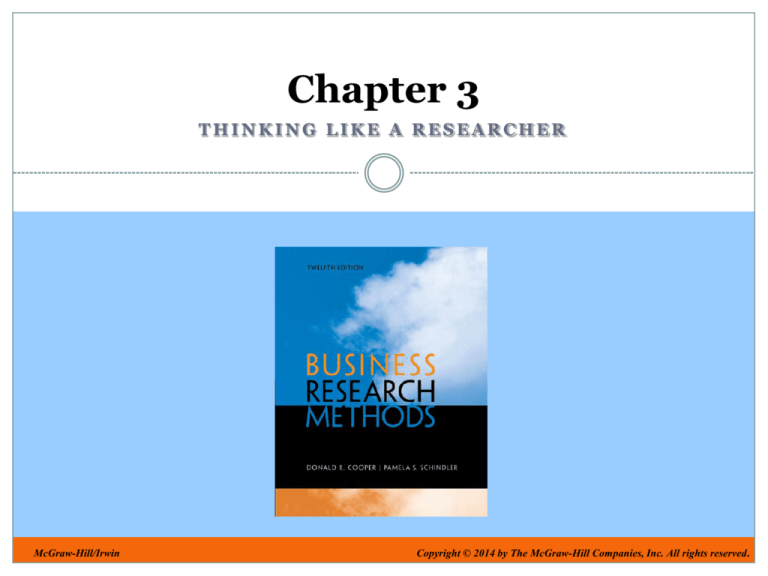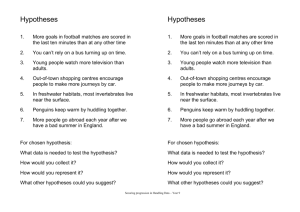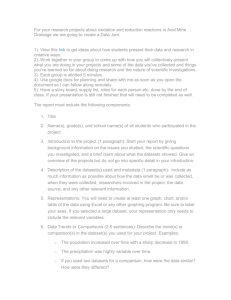
Chapter 3
THINKING LIKE A RESEARCHER
McGraw-Hill/Irwin
Copyright © 2014 by The McGraw-Hill Companies, Inc. All rights reserved.
Learning Objectives
Understand . . .
The terminology used by professional
researchers employing scientific thinking.
3-2
Language of Research
Concepts
Constructs
Models
Terms used
in research
Theory
Conceptual
schemes
Operational
definitions
Variables
Propositions/
Hypotheses
3-3
Language of Research
Success
of
Research
Clear conceptualization
of concepts
Shared understanding
of concepts
3-4
Job
Redesign
Constructs
and
Concepts
3-5
Operational Definitions: how will we
measure the variable?
How can we define the variable
“class level of students”?
Freshman
< 30 credit hours
Sophomore
30-50 credit hours
Junior
60-89 credit hours
Senior
> 90 credit hours
3-6
A Variable: Property Being Studied
Act
Event
(buying ticket)
(being selected for security check)
Variable
Characteristic
Trait
(rebellious daughter))
(sensitive nature)
Attribute
(daughter)
3-7
Types of Variables
Dichotomous
Male/Female
Employed/ Unemployed
Discrete (point)
Ethnic background
Educational level
Religious affiliation
Continuous (line)
Income
Temperature
Age
3-8
Independent and Dependent Variables
(Also known as…)
Independent Variable (IV)
Dependent Variable (DV)
Example: £ spent in Advertising
Example: £ earned in Sales
Predictor
Criterion
Presumed cause
Presumed effect
Stimulus
Response
Predicted from…
Predicted to….
Antecedent
Consequence
Manipulated
Measured outcome
3-9
Relationships Among Variable Types
MV: Moderating Variable)
3-10
Relationships Among Variable Types
Control Variable: They may have effect on DV, but we do not
want to study them, so we ”control” for them
Confounding Variable = type of work done (meeting versus non-meeting), they are
MVs or IVs, but found later in the study that we did not take them into account and
3-11
they ”confounded” the results. If we can measure them later, we can control for them.
Relationships Among Variable Types
IVV = Intervening Variable
Also known as Mediating Variable
3-12
Moderating Variables (MV)
The introduction of a four-day week (IV) will lead to
higher productivity (DV), especially among younger
workers (MV)
Class Exercise: Draw following in box-and-arrow diagrams
The switch to commission from a salary compensation
system (IV) will lead to increased sales (DV) per worker,
especially more experienced workers (MV).
The loss of mining jobs (IV) leads to acceptance of
higher-risk behaviors to earn a family-supporting income
(DV) – particularly among those with a limited education
(MV).
3-13
Intervening Variables (IVV)
• The switch to a commission compensation
system (IV) will lead to higher sales (DV) by
increasing overall compensation (IVV).
• A promotion campaign (IV) will increase savings
activity (DV), especially when free prizes are
offered (MV), but chiefly among smaller savers
(EV-control). The results come from enhancing
the motivation to save (IVV).
3-14
Propositions and Hypotheses
Brand Manager Jones (case) has a higher-than-
average achievement motivation (variable).
Generalization
Brand managers in Company Z (cases) have a
higher-than-average achievement motivation
(variable).
3-15
16
Hypothesis is
A proposed explanantion
A conjuncture.
An educated guess.
Yet to be tested
Examples
Online retailer’s communication with the ccustomers is related
to higher trust from customers
Online retailer’s strong privacy policies are related to higher
trust from customers
Online retailer’s web page with user friendliness is related to
higher satisfaction from customers
3-16
17
Theory is a series of interrelated hypotheses
Online retailer’s communication with the ccustomers is related
to higher trust from customers
Online retailer’s strong privacy policies are related to higher
trust from customers
Online retailer’s web page with user friendliness is related to
higher satisfaction from customers
xxxxxxxx
When theory is depcited as a diagram, it is called
”model”.
3-17
Consumer Relationship with Online Retailers
18
3-18
Descriptive Hypothesis Formats
Descriptive
Hypothesis
Research
Question
In Detroit, our
What is the market
potato chip market
share stands at
13.7%.
Finnish towns are
experiencing budget
difficulties.
share for our potato
chips in Detroit?
Are Finnish towns
experiencing budget
difficulties?
3-19
Relational Hypotheses Formats
Correlational
Young women (under
35) purchase fewer units
of our product than
women who are older
than 35.
The number of suits sold
varies directly with the
level of the business
cycle.
Causal
An increase in family
income leads to an
increase in the
percentage of income
saved.
Loyalty to a grocery
store increases the
probability of sales of
that store’s private
brand products.
3-20
The Role of Hypotheses
Guide the direction of the study
Identify relevant facts
Suggest most appropriate
research design
Provide framework for organizing
resulting conclusions
3-21
Characteristics of
Strong Hypotheses
Adequate
A
Strong
Hypothesis
Testable
Better
than rivals
3-22
What is the difference between theories and hypotheses?
Hypotheses tend to be simple, limited-variable
statements involving concrete occasions.
Theories tend to be complex, abstract, and involve
multiple variables.
Theory is a set of systematically interrelated
concepts, definitions, and propositions that are
advanced to explain or predict phenomena. To the
degree that our theories are sound and fit the
situation, we are successful in our explanations and
predictions.
The following slide has an example of a theory.
3-23
Herzberg’s Two factor Theory
Job satisfaction and job
dissatisfaction
caused by two different
Set of factors
3-24
Model versus Theory
25
A model is a representation of theory, in 2D, in 3D,
in picture, in an equation etc.
3-25
Examples of Models
Theory within Research
3-27
A Model Based on Justice Theory
28
3-28
The Scientific Method
Direct observation
Clearly defined variables
Clearly defined methods
Empirically testable
Elimination of alternatives
Statistical justification
Self-correcting process
3-29
Researchers
• Encounter problems
• State problems
• Propose hypotheses
• Deduce outcomes
• Formulate rival
hypotheses
• Devise and conduct
empirical tests
• Draw conclusions
3-30
Why is
curiosity
important?
3-31
Sound Reasoning
Types of Discourse
Exposition
Deduction
Argument
Induction
3-32
Deductive Reasoning: Conclusion must follow from the reasons (premises)
given.
Premise 1: Inner-city household
interviewing is especially difficult
and expensive
Premise 2: This survey involves
substantial inner-city household
interviewing
Conclusion: The interviewing in
this survey will be especially
difficult and expensive
3-33
Deductive Reasoning
Apply deductive
reasoning to this
image.
What will happen
next?
3-34
Inductive Reasoning: Inferring something beyond the evidence presented
Why didn’t sales increase during our
promotional event?
Regional retailers did not have sufficient stock
to fill customer requests during the
promotional period
A strike by employees prevented stock from
arriving in time for promotion to be effective
A hurricane closed retail outlets in the region
for 10 days during the promotion
3-35
Why Didn’t Sales Increase?
3-36
Tracy’s Performance
3-37
Key Terms
Concept
Conceptual scheme
Construct
Deduction
Hypothesis
Induction
Model
Operational definition
Proposition
Theory
Variable
Control
Confounding (CFV)
Dependent (DV)
Extraneous (EV)
Independent (IV)
Intervening (IVV)
Moderating (MV)
3-38












